引气活门(PRV)
一、名称
BLEED VALVE
引气活门(PRV)
二、件号
6774F010000,6774F010000 Amdt A,6774F010000 Amdt AB,6774G010000,6774G010000 Amdt A
三、章节号
36-11-28
四、适用机型
A320
五、系统
36 PNEUMATIC
气源
六、安装位置
发动机短舱
![图片[1]-6774G BLEED VALVE(PRV)-航修札记](https://www.aeroacm.cn/wp-content/uploads/2025/06/word-image-6886-1.png)
![图片[2]-6774G BLEED VALVE(PRV)-航修札记](https://www.aeroacm.cn/wp-content/uploads/2025/06/word-image-6886-2.png)
七、部件原理
C. Detailed Description
The Bleed Valve includes three main subassemblies (Refer to Figure 3 and Figure 4):
– A Butterfly Valve Assy
– A Pneumatic Actuator Assy
– A Regulator Assy.
For PNR 6774G010000 and 6774G010000 Amdt A
– An IPT/RPT Selector Assy, consisting in a clapper and seat, which allow switching between the internal and the remote downstream pressure port.
详细描述
引气活门包括三个主要子组件(参考图3和图4):
– 蝶板组件
– 气动作动器组件
– 调节器组件。
对于PNR 6774G010000和6774G010000 Amdt A
–IPT/RPT选择器组件,包括一个阀芯和阀座,用于在内部和远程下游压力端口之间切换。
![图片[3]-6774G BLEED VALVE(PRV)-航修札记](https://www.aeroacm.cn/wp-content/uploads/2025/06/word-image-6886-3.png)
![图片[4]-6774G BLEED VALVE(PRV)-航修札记](https://www.aeroacm.cn/wp-content/uploads/2025/06/word-image-6886-4.png)
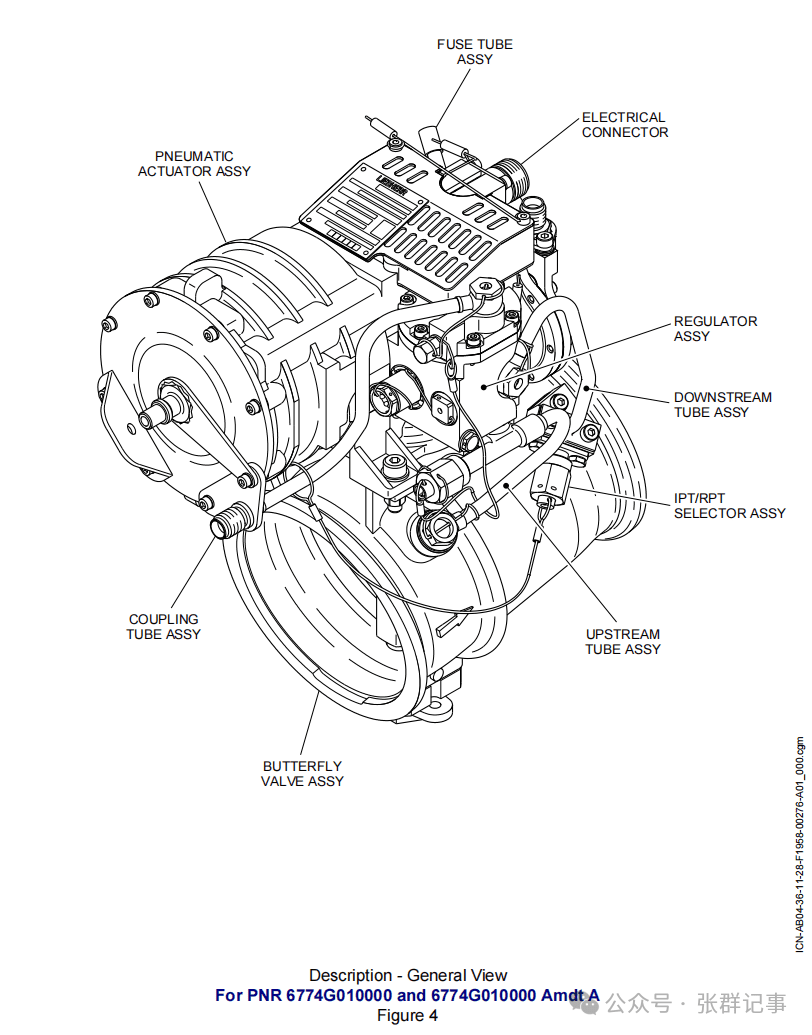
2. Operation
A. Regulator Operation (Refer to Figure 5) (Refer to Figure 6)
(1) Regulation Assy
(a) Normal operation
– The upstream pressure is reduced through clapper (3) and is supplied to the chamber (A) of the first regulation stage through a jet (1).
– This pressure acts on the diaphragm (2) to control the position of the clapper (3) which reduces the pressure.
– This delivers a constant reference pressure in the opening chamber of the pneumatic actuator.
– The reduced pressure can be adjusted by the adjusting nut which changes the load of spring (4) on diaphragm (2).
– The ground test union is used to check the correct operation of the valve on the ground by supplying the regulator with an external pressure source.
(2) Distribution Assy
– The downstream pressure is tapped through a trailing edge probe installed in the valve body.
– When the downstream pressure reaches the calibrated value of the spring (5) that holds the distribution clapper (6) on its lower seat, the clapper (6) moves and comes against with stop (7). The downstream pressure can flow into the closing chamber of the pneumatic actuator.
– When the downstream pressure level is not sufficient to overcome the load of spring (5) and, thus, to push the distribution clapper (6) on its upper seat, the air-venting of the actuator closing chamber takes effect through the distribution clapper (6).
(3) Opening/Closing Assy
– If the pressure is delivered into chamber (C), the diaphragm (8) pushes the clapper (9) into contact with its lower seat: the pressure is then applied into the opening chamber of the pneumatic actuator.
– In the absence of pressure in chamber (C), diaphragm (8) is returned by spring (10) in its upper position. Clapper (9) can go back against its upper seat: the pressure is then applied into the closing chamber of the pneumatic actuator between the ball (11) and its seat. The venting of the pneumatic actuator opening chamber is done through the clapper (9) and a hole drilled in the regulator body.
– The ball (11) loaded by spring (12) is also used as a non-return valve to protect the regulator from a back-pressure from the actuator closing chamber.
(4) Non-return Assy
The clapper (13) is held against its seat as long as the downstream pressure is lower than the spring (14) load. When the Bleed Valve is closed, it prevents a permanent downstream leakage from the regulator.
B. Valve Operating Configurations
(1) Valve at Rest (Refer to Figure 5 and Figure 6)
With no upstream pressure supply, the valve butterfly is kept in the closed position by the action of the spring pushing on the piston in the pneumatic actuator closing chamber.
2. 操作
A. 调节器操作(参见图5)(参见图6)
(1) 调节组件
(a) 正常操作
– 上游压力通过阀芯(3)降低,并通过节流孔(1)供应到第一调节级的腔室(A)。
– 该压力作用于膜片(2),以控制阀芯(3)的位置,从而降低压力。
– 这为气动作动器的开启腔提供恒定的参考压力。
– 通过调节螺母可以改变膜片(2)上弹簧(4)的载荷,从而调节减压后的压力。
– 通过向调节器提供外部压力源,接地测试接头可用于检查活门在地面上的正确操作。
(2) 分配组件
– 通过安装在活门壳体上的后缘探头测量下游压力。
– 当下游压力达到将分配阀芯(6)固定在下方阀座上的弹簧(5)的校准值时,阀芯(6)移动并与止动件(7)接触。下游压力可以流入– 气动作动器的关闭腔。
– 当下游压力不足以克服弹簧(5)的载荷,从而推动分配阀芯(6)到达其上阀座时,作动器关闭室的排气通过分配阀芯(6)生效。
(3) 开启/关闭组件
– 如果压力传递到腔室(C),膜片(8)将阀芯(9)推至与其下阀座接触:压力随后施加到气动作动器的开启腔室。
– 如果腔室(C)中没有压力,膜片(8)在弹簧(10)的作用下返回到其上位置。阀芯(9)可以回到其上阀座:压力随后施加到气动作动器的关闭腔室中,作用在球(11)及其阀座之间。气动作动器打开腔室的排气通过阀芯(9)和调节器壳体上钻出的孔完成。
– 弹簧(12)加载的球(11)还用作单向阀,以保护调节器免受来自作动器关闭室的背压。
(4) 单向阀组件
只要下游压力低于弹簧(14)载荷,阀芯(13)就会紧贴阀座。当引气阀关闭时,它可以防止调节器下游出现永久性泄漏。
B. 活门操作配置
(1) 静止状态下活门(参见图5和图6)
在没有上游压力供应的情况下,活门蝶板在气动作动器关闭腔内活塞上弹簧的作用下保持在关闭位置。
![图片[6]-6774G BLEED VALVE(PRV)-航修札记](https://www.aeroacm.cn/wp-content/uploads/2025/06/word-image-6886-6.png)
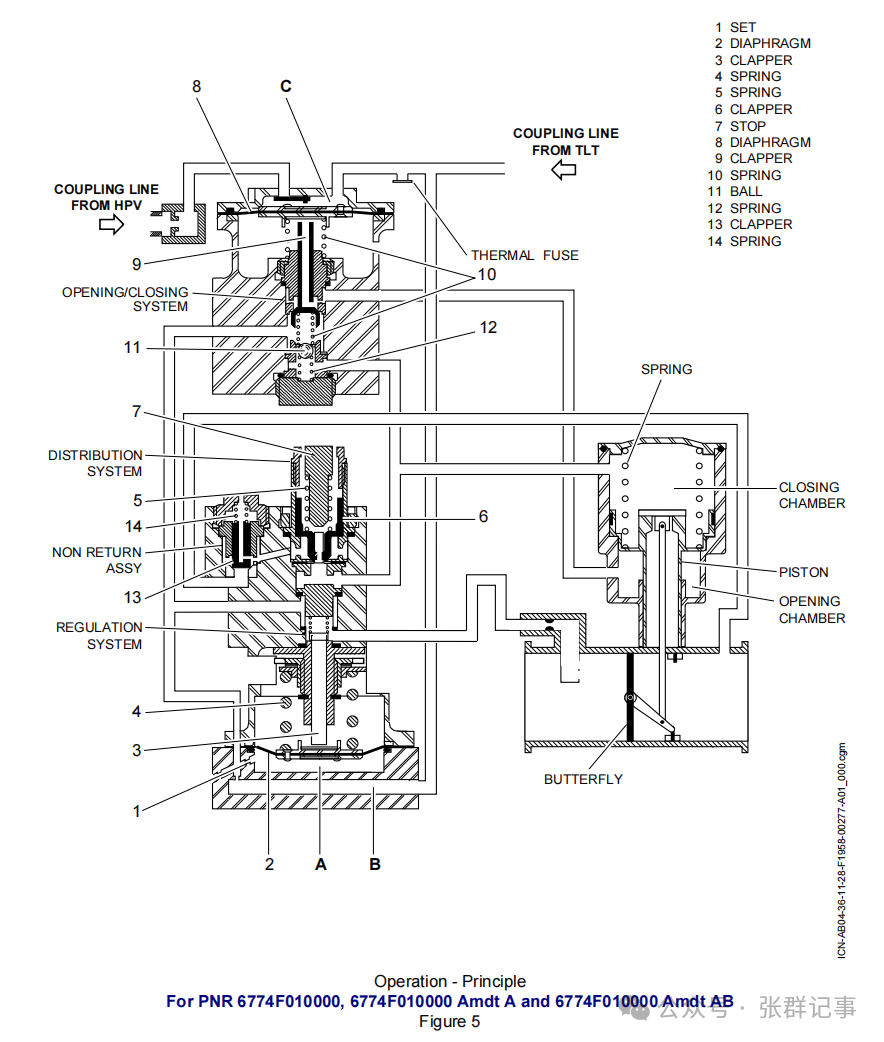
![图片[8]-6774G BLEED VALVE(PRV)-航修札记](https://www.aeroacm.cn/wp-content/uploads/2025/06/word-image-6886-8.png)
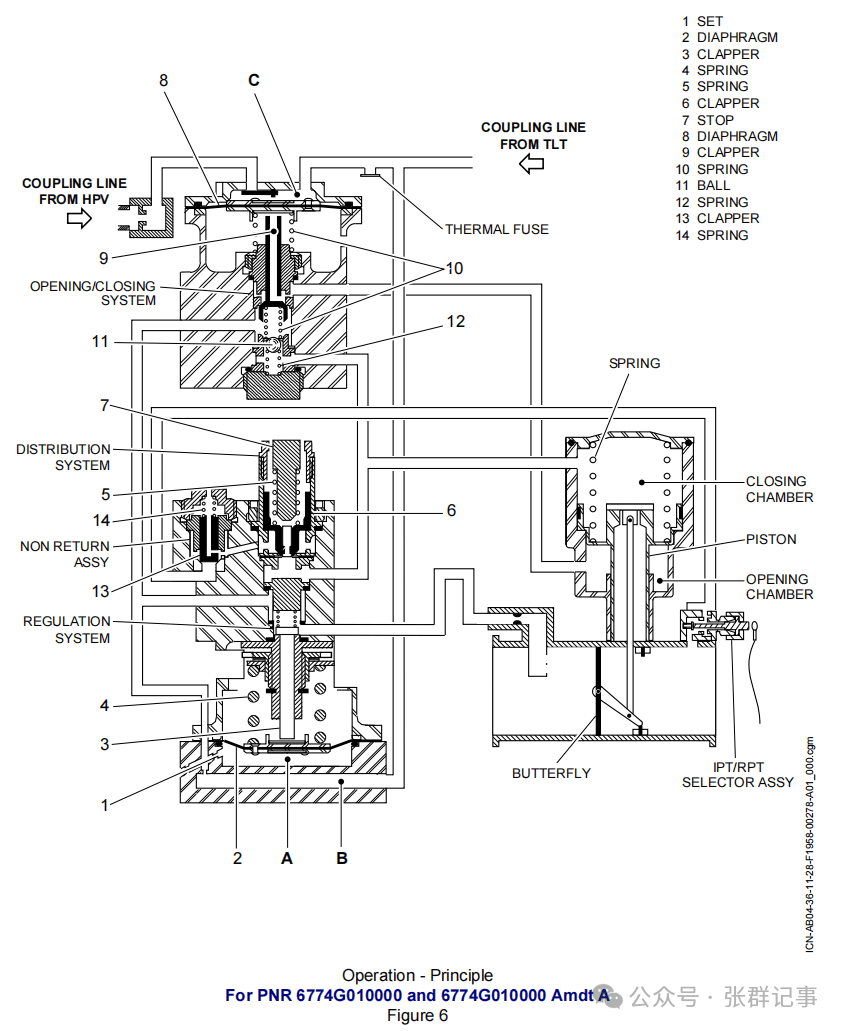
(2) Valve Full Opening (Refer to Figure 7 and Figure 8)
When the pressure bleed from the IP stage is too low, the Bleed Valve is pneumatically supplied by the Bleed Valve downstream pressure.
A ball bleed valve stops the flow of the upstream pressure to the closing chamber of the pneumatic actuator as long as the clapper (9) is kept in the top position.
The upstream pressure supplied into the opening chamber of the pneumatic actuator counteracts the spring load.
The resulting force causes the valve to open fully with a 0.550 bar rel. (7.98 psig) maximum pressure.
(2) 活门全开(参见图7和图8)
当来自IP级的压力引气过低时,引气活门由下游压力提供气动源。
只要阀芯(9)保持在顶部位置,球阀就会阻止上游压力流向气动作动器的关闭腔。
供给气动作动器开启腔的上游压力抵消了弹簧载荷。
产生的力使活门在0.550 bar相对压力(7.98 psig)的最大压力下完全打开。
![图片[10]-6774G BLEED VALVE(PRV)-航修札记](https://www.aeroacm.cn/wp-content/uploads/2025/06/word-image-6886-10.png)
![图片[11]-6774G BLEED VALVE(PRV)-航修札记](https://www.aeroacm.cn/wp-content/uploads/2025/06/word-image-6886-11.png)
(3) Pressure Control (Refer to Figure 9 and Figure 10)
When the IP bleed pressure is sufficient, the bleed pressure is supplied by the IP engine stage to the Bleed Valve.
As soon as the upstream pressure is at a given level (higher than 3 bar rel. (43.5 psig), the valve controls its downstream pressure to a limited value: 3.03 ± 0.21 bar rel. (43.95 ± 3.05 psig). The downstream pressure causes the distribution valve to open and then can be supplied into the closing chamber of the pneumatic actuator while the opening chamber of the pneumatic actuator is submitted to a constant regulated pressure.
Any change in the downstream pressure causes a change in the position of the butterfly to keep the downstream pressure constant.
(3) 压力控制(参见图9和图10)
当IP引气压力足够时,引气压力由IP发动机级提供给引气活门。
一旦上游压力达到给定水平(高于3 bar相对压力(43.5 psig)),活门就会将其下游压力控制在限定值: 3.03 ± 0.21 bar相对压力(43.95 ± 3.05 psig)。下游压力使分配阀打开,然后可以供应到气动作动器的关闭腔,而气动作动器的打开腔则受到恒定的调节压力。
下游压力的任何变化都会导致蝶板位置的变化,以保持下游压力恒定。
![图片[12]-6774G BLEED VALVE(PRV)-航修札记](https://www.aeroacm.cn/wp-content/uploads/2025/06/word-image-6886-12.png)
![图片[13]-6774G BLEED VALVE(PRV)-航修札记](https://www.aeroacm.cn/wp-content/uploads/2025/06/word-image-6886-13.png)
(4) Valve Full Closing (Non-Return Function) (Refer to Figure 11 and graphic-36-11-28-991-012-b01)
When the precooler downstream pressure is more than the valve upstream pressure, the solenoid thermostat, which monitors their differential pressure, vents the coupling line. This vents the chamber of the closing sub-assembly, and causes the closing clapper to vent the opening chamber of the pneumatic actuator and supplies the reference pressure into the closing chamber of the pneumatic actuator to close the valve fully.
(5) Electrically-Controlled Full Closing (Refer to Figure 11 and Figure 12)
(a) The solenoid of the solenoid thermostat, when energized, vents the closing chamber of the pneumatic actuator, and causes the valve to close fully.
NOTE: If the Bleed Valve closes, the pneumatic line between the Regulator Assy and the chamber of the HP valve closing sub-assembly closes the HP valve fully.
NOTE: If the engine is on fire, the thermal fuse vents the pressure from the chamber (C) of the opening/closing Assy, and causes the valve to close fully.
(4) 活门完全关闭(单向功能)(参见图11和图36-11-28-991-012-b01)
当预冷器下游压力大于活门上游压力时,监测两者压差的电磁阀恒温器会打开连接管路。关闭子组件的腔室因此打开,关闭阀芯打开气动作动器的开口腔室,并向气动作动器的关闭腔室提供参考压力,以完全关闭活门。
(5) 电动全关(参见图11和图12)
(a) 电磁恒温器的电磁线圈通电时,会排出气动作动器的关闭腔室,使活门完全关闭。
注意:如果引气活门关闭,调节器组件和高压活门关闭子组件之间的气动管路将使高压活门完全关闭。
注意:如果发动机着火,热熔断器将打开/关闭组件的腔室(C)中的压力释放,并使活门完全关闭。
![图片[14]-6774G BLEED VALVE(PRV)-航修札记](https://www.aeroacm.cn/wp-content/uploads/2025/06/word-image-6886-14.png)
![图片[15]-6774G BLEED VALVE(PRV)-航修札记](https://www.aeroacm.cn/wp-content/uploads/2025/06/word-image-6886-15.png)
八、工作环境
![图片[16]-6774G BLEED VALVE(PRV)-航修札记](https://www.aeroacm.cn/wp-content/uploads/2025/06/word-image-6886-16.png)
在飞机系统中的工作原理及互联
The bleed pressure regulator valve is installed in the duct downstream of the IP bleed check valve and the HP bleed valve . The bleed pressure regulator valve also operates pneumatically but opening and closing can be controlled by a bleed pressure regulator valve control solenoid (10HA). The solenoid is installed in the duct downstream of the bleed air precooler exchanger (7150HM). The solenoid controls the bleed pressure regulator valve which controls the HP bleed valve at the same time.
During cruise in normal bleed condition, the solenoid (4029KS) (installed in the fan compartment) is energized. This causes the solenoid opens to ambient the HPV PRV coupling sense line which lets the HPV close pneumatically. It avoid a permanent HP bleed due to low IP engine pressures.
引气压力调节活门安装在IP引气单向活门和HP引气活门的下游管道中。引气压力调节活门也是通过气动方式操作,但可通过引气压力调节活门控制电磁阀(10HA)控制其开启和关闭。电磁阀安装在引气空气预冷器(7150HM)的下游管道中。电磁阀控制引气压力调节活门,后者同时控制高压引气活门。
在正常引气状态下巡航时,风扇舱内的电磁阀(4029KS)通电。这会导致电磁阀打开,连接HPV PRV耦合传感管,使HPV以气动方式关闭。这可以避免因发动机内部压力过低而造成持续的高压引气。
(1) The PRV is a 4 in. dia. butterfly-type valve, normally spring-loaded closed in absence of upstream pressure. A minimum upstream pressure of 8 psig is necessary to open the valve.The PRV pneumatically regulates the downstream pressure to 44 plus or minus 3 psig.
It closes automatically in the following cases :
– overtemperature downstream of the precooler exchanger (257 plus or minus 3) deg.C (60 s delay)
– overpressure downstream of the PRV (57 plus or minus 3) psig (15 s delay)
– ambient overheat in pylon/wing/fuselage duct surrounding areas
– APU bleed valve not closed
– corresponding starter valve not closed.
It is controlled in closed position by crew action on:
– ENG FIRE pushbutton switch
– ENG BLEED pushbutton switch.
The PRV closes pneumatically in case of impending reverse flow to the engine. The Overpressure Valve (OPV) installed downstream of the PRV protects the system against damage if overpressure occurs.
A sense line (1/4 in. dia.) connects the PRV to the HP Bleed Valve in order to close the HP Bleed Valve if the PRV is closed or controlled to close. The thermal fuse installed in the valve body causes the valve to close at 450 plus or minus 25 deg.C.
(1) PRV是一个直径为4英寸的蝶板型活门,在没有上游压力的情况下,通常由弹簧载荷关闭。打开活门需要至少8 psig的上游压力。PRV通过气动方式将下游压力调节到44 psig(±3 psig)。
在以下情况下自动关闭:
– 预冷器换热器下游超温(257±3)摄氏度(延迟60秒
– PRV下游超压(57±3)psig(延迟15秒
– 机翼/机身管道周围环境过热
– APU引气活门未关闭
– 相应的启动活门未关闭。
机组人员可通过以下操作将其控制在关闭位置:
– 发动机火灾按钮开关
– 发动机引气按钮开关。
如果即将发生向发动机的反向流动,PRV将自动关闭。安装在PRV下游的超压活门(OPV)可在超压情况下保护系统免受损坏。
一根感应管(直径1/4英寸)将PRV与高压引气活门连接起来,以便在PRV关闭或受控关闭时关闭高压引气活门。活门壳体中安装的热熔断器可在450摄氏度(正负25度)时关闭活门。
![图片[17]-6774G BLEED VALVE(PRV)-航修札记](https://www.aeroacm.cn/wp-content/uploads/2025/06/word-image-6886-17.png)
![图片[18]-6774G BLEED VALVE(PRV)-航修札记](https://www.aeroacm.cn/wp-content/uploads/2025/06/word-image-6886-18.png)
![图片[19]-6774G BLEED VALVE(PRV)-航修札记](https://www.aeroacm.cn/wp-content/uploads/2025/06/word-image-6886-19.png)
The PRV contains three main parts :
– a valve body,
– a pneumatic actuator,
– a regulator assembly.
(a) Regulation
The upstream pressure supplies chamber (1) of the regulator through a jet to control the position of the clapper (2) and maintain constant air pressure in the actuator opening chamber.
PRV包含三个主要零件:
– 活门壳体、
– 气动作动器、
– 调节器组件。
(a) 调节
上游压力通过节流孔供应调节器的腔室(1),以控制阀芯(2)的位置,并维持作动器开口腔室内的恒定气压。
![图片[20]-6774G BLEED VALVE(PRV)-航修札记](https://www.aeroacm.cn/wp-content/uploads/2025/06/word-image-6886-20.png)
![图片[21]-6774G BLEED VALVE(PRV)-航修札记](https://www.aeroacm.cn/wp-content/uploads/2025/06/word-image-6886-21.png)
The regulator calibration can be modified by the secondary stage of the regulator which is pneumatically connected to the Bleed Pressure regulator valve Control Soleno]d according to the air temperature sensed downstream to the PCE. The air pressure in chamber (3) can vary according to an air leakage controlled by the Bleed Pressure Regulator Valve Control Solenoid. As clapper
(2) remains in contact with its seat (4), downstream pressure still supplies the actuator closing chamber despite a reduced pressure air value lower than the nominal regulation threshold.The test intake is used for checking correct valve operation on the ground by directly supplying the regulator. The downstream pressure supplies the actuator closing chamber through distribution clapper (4). Indeed when downstream pressure reaches the value determined by spring preloading.
(b) Opening/Closing
Reduced pressure air supplies chamber (5) of the opening/closing sub assembly though a jet to control the position of clapper (6) against its lower seat position and allow the HP Bleed Valve
actuator opening chamber supply with reduced pressure air.When chamber (5) is vented to ambient the clapper (6) leaves its lower seat position and reduced pressure air is allowed to supply the HP Bleed Valve actuator closing chamber.
(c) Safety devices and indications
A thermal fuse (7) permits to vent to ambient chamber (5) of the opening/closing subassembly. This causes the valve to close. The PRV is equipped with an upstream pressure test port which permits you to perform an _in situ_ test.
A manual override permits you to close the valve mechanically on the ground.
The microswitch in the valve signals the extreme position (closed) of the butterfly plate.
(3) Control and Indicating
PRV operation is fully pneumatic. The PRV can be controlled in close position from the AIR COND overhead control panel. The pushbutton switches (ENG 1 (2) BLEED) energize/de-energize the solenoid. The lower ECAM display unit indicates its position on the BLEED page. (Ref. Fig. 011)
The two BMCs monitor the operation of the PRV (closed microswitch signal and regulated pressure level). They receive and process the signals and transmit the information per data bus by the SDAC to the ECAM system which generates the system display (Ref. 36-20-00). Additionally, they transmit the information to the CFDIU. The CFDIU generates maintenance information which is displayed on the MCDU if the MCDU MENU is selected.
通过节流孔控制阀芯(6)的位置,使其保持在阀座下方,为高压引气活门
作动器打开腔室提供低压空气。当腔室(5)与外界相通时,阀芯(6)离开阀座下方,低压空气进入高压引气活门作动器关闭腔室。
(c) 安全装置和指示
热熔断器(7)允许打开/关闭组件的腔室(5)向环境通风。这会导致活门关闭。PRV配备了一个上游压力测试端口,允许您进行_现场_测试。
手动超控允许您在地面上机械关闭活门。
活门中的微动开关会发出蝶板处于极端位置(关闭)的信号。
(3) 控制和指示
PRV操作完全由气动控制。PRV可通过空调顶置控制面板控制在关闭位置。按钮开关(ENG 1 (2) BLEED)用于通电/断电。ECAM下部显示单元在“引气”页面上显示其位置。(参考图011)
两个BMC监控PRV的操作(闭合微动开关信号和调节压力水平)。它们接收和处理信号,并通过SDAC将信息传输到ECAM系统,由ECAM系统生成系统显示(参考编号36-20-00)。此外,它们还将信息传输到CFDIU。如果选择了MCDU MENU,CFDIU将生成维护信息,并在MCDU上显示。
PRV/CONTROL SOLENOID
The PRV pneumatically regulates the bleed pressure around 44 psi. A thermal fuse causes the valve to close in case of engine fire at 450°C (842°F). The PRV is pneumatically controlled by an external servo-control, the bleed pressure regulated valve control solenoid (CTL SOL), located downstream from the precooler. The control solenoid operates in two modes, pneumatic and electric, causing complete closure of the PRV. The pneumatic mode is used for:
– reverse flow protection
– the PRV is closed when a delta pressure between the precooler outlet and the PRV inlet is detected.
The electrical mode with PRV shut-off function through energization of the control solenoid is used when:
– the ENGine BLEED P/B is selected “OFF”,
– the ENGine FIRE P/B is RELEASED OUT,
The solenoid is automatically energized by the BMC in the following cases:
– over-temperature downstream of the precooler
– the heat exchanger outlet temperature sensor senses a temperature above 257°C (527°F),
– overpressure downstream of the PRV when the pressure-regulated transducer senses a pressure greater than 57 psi,
– leak detection in pylon/wing/fuselage ducts and surrounding areas,
– APU bleed valve not closed,
– corresponding starter valve not closed.
PRV/控制电磁阀
PRV 可气动调节 44 psi 左右的引气压力。当发动机在 450°C (842°F) 温度下起火时,热熔断器会使活门关闭。PRV 由一个外部伺服控制器进行气动控制,即位于预冷却器下游的放气压力调节阀控制电磁阀 (CTL SOL)。控制电磁阀在气动和电动两种模式下工作,导致 PRV 完全关闭。气动模式用于:
– 逆流保护
– 当检测到预冷却器出口和 PRV 入口之间存在压差时,PRV 关闭。
通过控制电磁阀通电实现 PRV 关闭功能的电气模式用于以下情况
– ENGine BLEED P/B 选择 “OFF(关闭)”、
– ENGine FIRE P/B 被释放、
在下列情况下,BMC 会自动启动电磁阀:
– 预冷却器下游温度过高
– 热交换器出口温度传感器检测到温度超过 257°C (527°F)、
– 当压力调节传感器检测到压力超过 57 psi 时,PRV 下游出现超压、
– 吊架/机翼/机身管道和周围区域的泄漏检测、
– APU 引气活门未关闭、
– 相应的启动器活门未关闭。
![图片[22]-6774G BLEED VALVE(PRV)-航修札记](https://www.aeroacm.cn/wp-content/uploads/2025/06/word-image-6886-22.png)
ENGINE AIR BLEED SELECTION
When one engine or both engines run and the APU runs, each PRV remains electrically closed by the related Bleed Monitoring Computer (BMC). When both engines run, the APU continues to supply air as long as the APU bleed valve remains open. When the APU BLEED valve P/BSW is released out, the APU bleed valve closes, the X BLEED valve closes automatically and the PRVs open.
发动机引气选择
当一台发动机或两台发动机运行且 APU 运行时,每个 PRV 都会通过相关的引气监控计算机 (BMC) 保持电动关闭。当两个发动机都运行时,只要 APU 引气活门保持打开,APU 就会继续供气。当 APU 引气活门 P/BSW 释放出来时,APU引气活门关闭,交输活门自动关闭,PRV 打开。
![图片[23]-6774G BLEED VALVE(PRV)-航修札记](https://www.aeroacm.cn/wp-content/uploads/2025/06/word-image-6886-23.png)
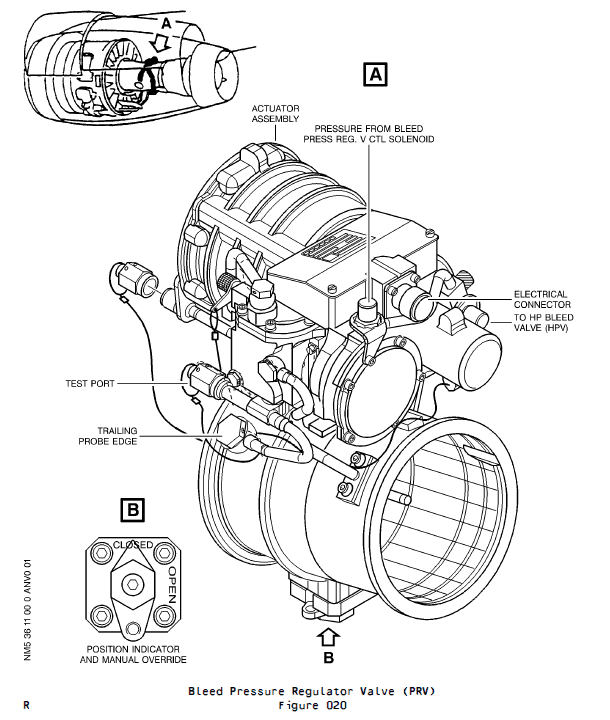
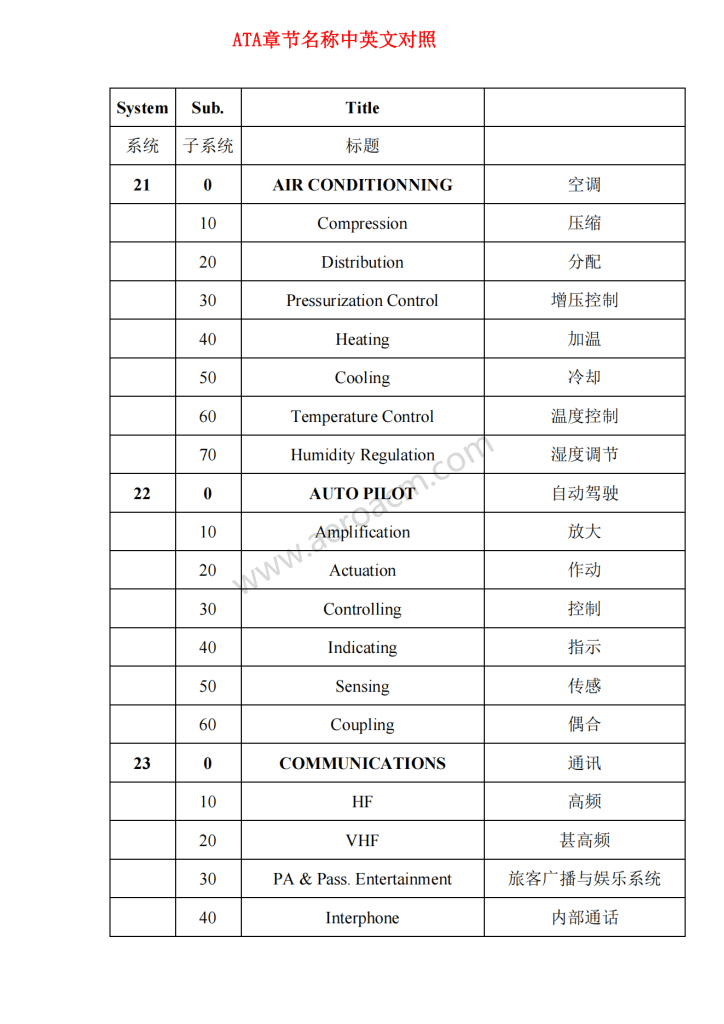
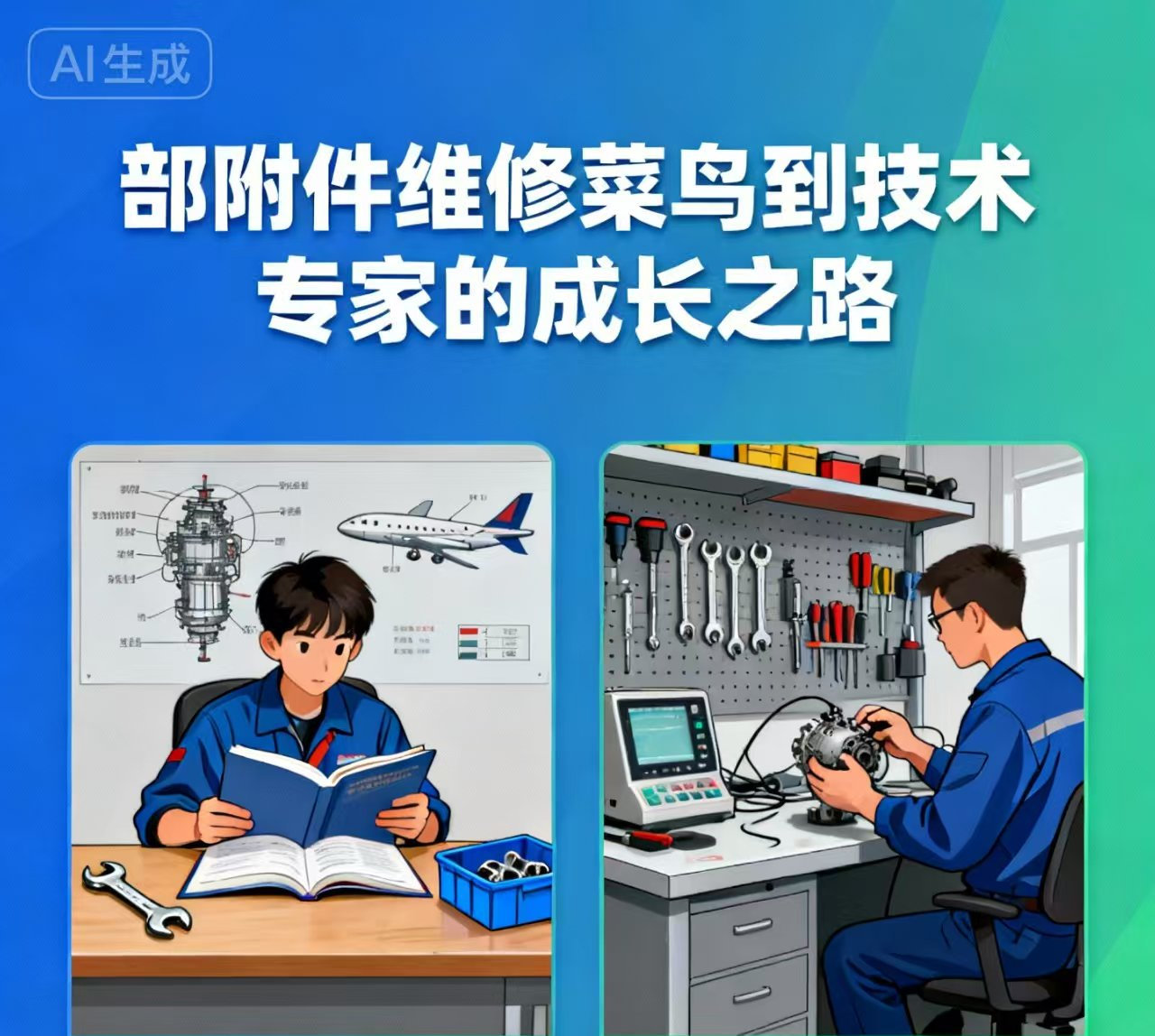

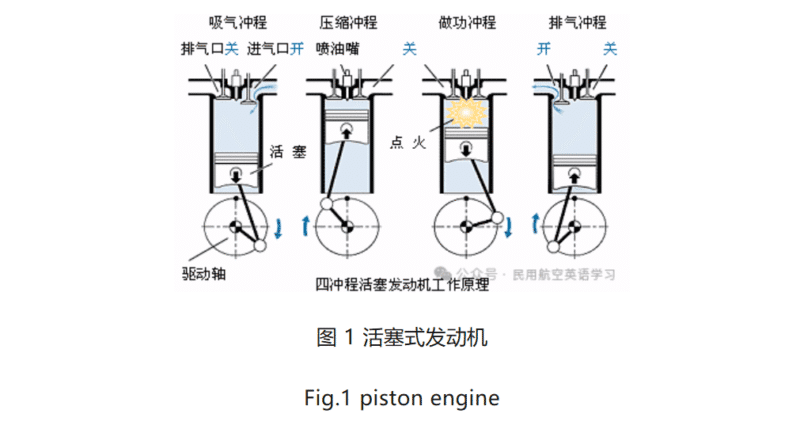
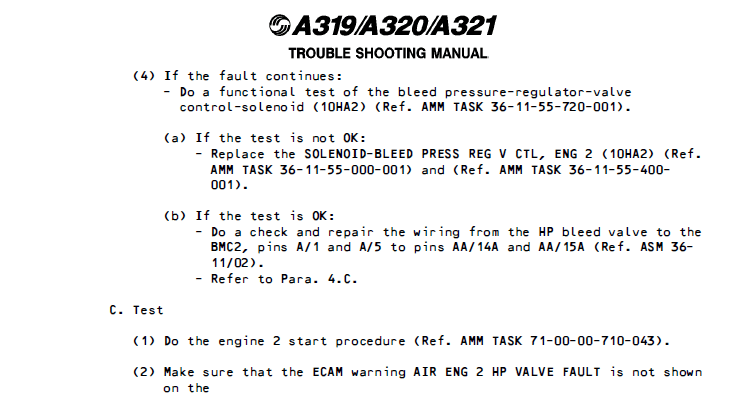




暂无评论内容